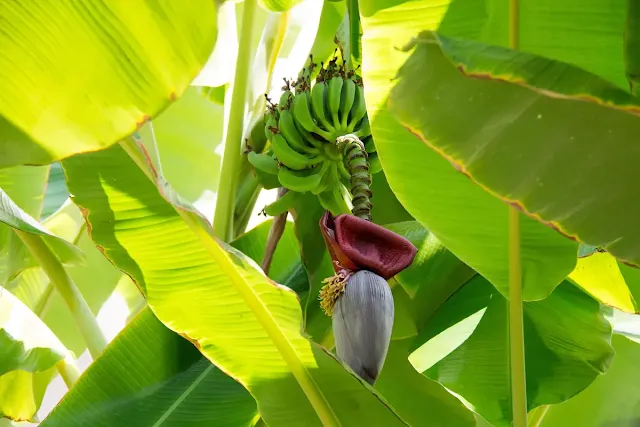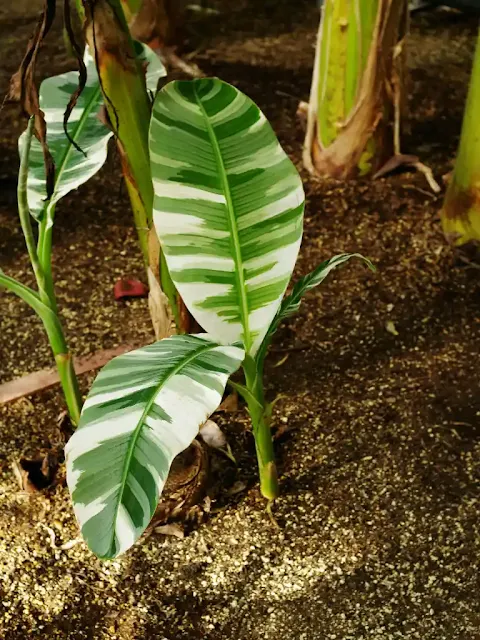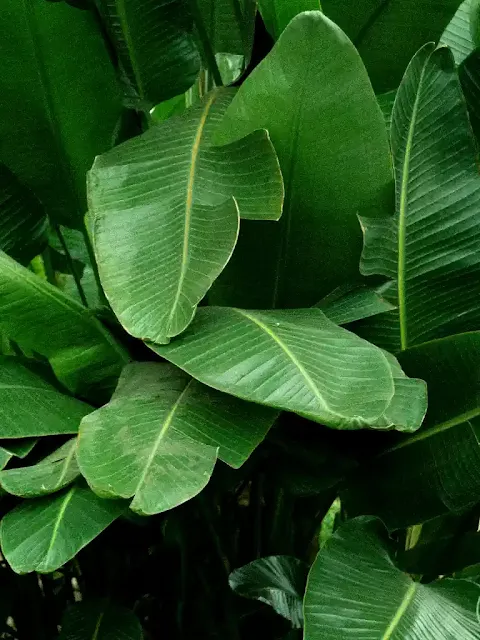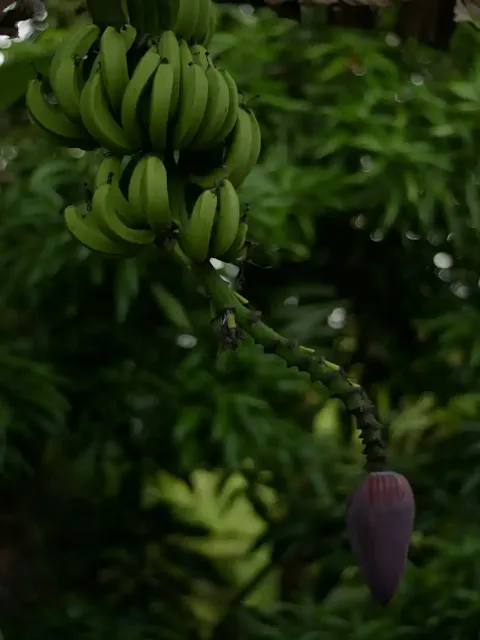Banana plants are more than just tropical eye candy — they’re fast-growing, surprisingly low-maintenance, and can even bear fruit in the right conditions. Whether you’re cultivating a lush backyard oasis or trying your hand at growing tropical plants indoors, banana trees (technically giant herbs!) make a striking and rewarding addition.
But growing a healthy banana plant requires more than just sunshine and water. From choosing the right variety to mastering soil conditions, watering habits, and pest control, this guide will walk you through everything you need to know.
In this post, we’ll break it down into three key areas: how to grow, care for, and maintain a thriving banana plant — even if you live outside the tropics.
Let’s dive into the world of lush green leaves, sun-loving growth, and maybe even your own homegrown bananas.
Banana Plant Overview
Name: Banana Plant
Family: Musaceae
Mature Size: 10 to 30 feet tall, depending on the variety, with a spread of up to 15 feet
Plant Type: Herbaceous perennial (though often treated as a tropical shrub or small tree)
Botanical Name: Musa spp.
Sun Exposure: Full sun to partial shade
Soil Type: Well-draining, fertile, and slightly acidic soil (pH 5.5-7.0)
Bloom Time: Depending on the variety, the bloom time can vary, but typically in the warmer months when the plant is actively growing. Banana flowers are seen in spring to early summer.
Flower Color: The banana plant’s flower is typically deep purple with a yellowish tint, but the true flower petals are hidden beneath layers of bracts.
Hardiness Zones: 8-11 (though it can be grown in other zones as an annual or in containers that are brought indoors during winter)
Native Area: Native to Southeast Asia and parts of the Indo-Malay region, though now grown in tropical regions around the world.
Toxicity: Non-toxic to humans and pets.
Topics Related To Plants:
How to Grow a Banana Plant
Growing banana plants is a rewarding endeavor for gardeners seeking a lush, tropical vibe — and possibly their own fruit harvest. Whether you’re planting outdoors in a warm climate or starting an indoor banana tree plant, following the right steps from the beginning is key.
Choosing the Right Banana Variety
Before planting, it’s essential to select the right banana variety based on your climate and space:
- Musa acuminata is one of the most common banana species, known for its sweet fruit and lush growth. Ideal for warm climates.
- Musa basjoo is a cold-hardy variety that can survive in USDA zones as low as 5–7 with proper winter protection — perfect for temperate regions.
- Dwarf banana plants, such as Dwarf Cavendish, grow only 4–6 feet tall and are great for containers or indoor growing.
- Full-sized varieties like Grand Nain or Rajapuri require more space and are better suited for outdoor gardens in tropical or subtropical zones.
Match your choice to your growing conditions and whether you're aiming for ornamental beauty or actual bananas.
Ideal Growing Conditions
Banana plants thrive in warm, humid environments with plenty of sunlight. Here’s what they need to grow successfully:
- Climate: Best suited for tropical and subtropical regions. Indoor growing is possible in cooler climates with proper light and warmth.
- USDA Hardiness Zones: Most banana trees flourish in zones 9–11, though cold-hardy varieties like Musa basjoo can handle cooler zones with protection.
- Sunlight: Full sun exposure is crucial — aim for 6 to 8 hours of direct sunlight per day for vigorous growth.
Humidity is also important, especially for indoor plants. Consider misting the leaves or using a humidity tray if growing indoors.
Soil Preparation
Healthy soil is the foundation of a thriving banana plant. Focus on these key factors:
- Soil type: Choose well-draining soil that retains moisture but doesn't stay soggy. A sandy loam mixed with compost works well.
- Organic matter: Banana plants are heavy feeders. Mix in plenty of compost or aged manure to enrich the soil and promote strong root development.
- Mulch: Add a layer of organic mulch around the base to conserve moisture, suppress weeds, and improve soil structure.
- pH level: Banana plants prefer a slightly acidic to neutral soil — aim for a pH between 5.5 and 7.0.
Planting Instructions
Once your soil and site are ready, it’s time to plant:
- Propagation: Banana plants can be grown from suckers (also called pups), which are small offshoots from a mature plant, or purchased as potted plants from a nursery.
- Container vs. ground: For colder zones or limited space, choose a large container (15+ gallons) with drainage holes. Otherwise, plant directly in the ground with ample room to spread.
- Spacing: If planting more than one, space them at least 5 to 10 feet apart, depending on the variety, to ensure airflow and root space.
- Depth: Plant suckers or young plants at the same depth they were growing in the pot or previous location, covering the roots but not the crown.
Water thoroughly after planting and keep the soil consistently moist (but not waterlogged) during the establishment phase.
Caring for Your Banana Plant
Proper banana plant care is essential to ensure healthy growth, vibrant foliage, and — if you're lucky — a bunch of delicious homegrown bananas. Whether grown indoors or outside, banana trees need consistent attention to thrive in their environment.
Watering Needs
Banana plants love moisture, but too much or too little can quickly cause stress.
- Keep the soil consistently moist, but avoid waterlogging. Water deeply when the top inch of soil feels dry.
- Outdoor banana plants may need daily watering during hot, dry spells, while indoor plants typically require less frequent watering, especially in winter.
- Signs of overwatering: Yellowing leaves, soggy soil, root rot.
- Signs of underwatering: Drooping leaves, dry edges, and slow growth.
To maintain the right balance, always check soil moisture before watering and ensure proper drainage.
Fertilizing Schedule
Banana plants are heavy feeders and need regular nutrition to support their fast growth and large leaves.
- Use a high-potassium (K-rich) fertilizer, such as a balanced 8-10-8 or a special banana plant mix.
- Feed monthly during the active growing season (spring through summer).
- In fall and winter, reduce feeding, especially for indoor plants.
- Organic options like compost tea, worm castings, or aged manure provide steady nutrients and improve soil health.
- Apply fertilizer around the base (but not directly on the trunk) and water it in to boost absorption.
Topics Related To Garden:
Light & Temperature Requirements
As tropical plants, banana trees demand warmth and sunlight.
- Light: Aim for 6–8 hours of full sun daily. Indoor plants should be placed near a south-facing window or under grow lights.
- Temperature: Ideal range is 75°F to 95°F (24°C to 35°C). Growth slows below 60°F (15°C) and stops under 50°F (10°C).
- Humidity: Banana plants thrive in 50–70% humidity. For indoor setups, consider a humidifier, pebble tray, or regular misting.
Avoid cold drafts or sudden temperature drops, as these can cause leaf damage or stunted growth.
Common Pests and Diseases
Though relatively resilient, banana plants are vulnerable to certain pests and diseases.
Pests:
- Aphids: Often cluster on new growth; can cause curled leaves.
- Spider mites: Look for webbing and tiny spots on leaves.
- Banana weevils: Attack the base of the plant; more common outdoors.
Diseases:
- Panama disease (Fusarium wilt): A serious fungal infection; causes yellowing and wilting.
- Leaf spot (Sigatoka): Yellow or black spots on leaves.
- Chlorosis: General yellowing, often caused by poor nutrition or overwatering.
Prevention and treatment tips:
- Inspect regularly and remove affected leaves.
- Use neem oil or insecticidal soap for pests.
- Maintain good air circulation and avoid overwatering to prevent fungal issues.
- Rotate plants or replace soil annually for indoor banana trees.
Maintaining a Healthy Banana Plant
Keeping your banana plant healthy long-term involves more than just basic care — it’s about ongoing attention to pruning, support, seasonal protection, and eventually, harvesting. These banana plant growing tips will help you sustain vibrant growth and maximize the life of your plant.
Pruning and Cleaning
Regular maintenance goes a long way in preventing disease and promoting new growth.
- Remove dead or damaged leaves as they appear. Use clean, sharp shears to avoid tearing and spreading disease.
- Manage offshoots (pups): Banana plants naturally produce suckers. Leave one or two strong pups to replace the mother plant after fruiting, and remove the rest to direct energy to the main stalk.
- Encourage airflow: Thinning out dense foliage helps reduce the risk of fungal infections and improves light penetration.
Keeping the plant tidy not only improves appearance but also boosts overall plant health.
Supporting Growth
As banana plants grow quickly and can become top-heavy, especially when fruiting, support is often needed.
- Stake taller varieties to prevent leaning or snapping in strong winds or heavy rain.
- Encourage flowering and fruiting by maintaining consistent watering and monthly feeding during the growing season.
- If stems become weak or bend, support them with bamboo stakes or plant ties, and avoid moving the plant unnecessarily.
Healthy banana plants often flower and fruit within 9 to 18 months, depending on the variety and growing conditions.
Overwintering and Cold Protection
If you live in a cooler climate, overwintering is essential to keep your banana plant alive through cold months.
- Bring containers indoors before the first frost. Place them in a bright, warm spot and reduce watering.
- For outdoor plants, mulch heavily around the base with straw, leaves, or wood chips to protect the root system.
- Musa basjoo, a cold-hardy variety, can survive in USDA Zones 5–7 with proper mulching and protection. In extremely cold climates, cut the plant back and insulate the root ball.
- Avoid fertilizing in winter, and resume active care in early spring as temperatures rise.
When and How to Harvest
With the right care, your banana plant may reward you with fruit. Here’s how to make the most of it:
- Recognize ripe bananas by their full size, light green to yellowing color, and plump feel. Bananas typically ripen off the plant.
- Cut the entire bunch with a sharp knife once the first few bananas begin turning yellow. Hang it indoors to fully ripen.
- Post-harvest care: After fruiting, the main stalk will die back — cut it to the ground and allow one of the healthy pups to take over.
- To encourage future fruiting cycles, continue consistent care and consider rotating the plant or refreshing its soil annually.





